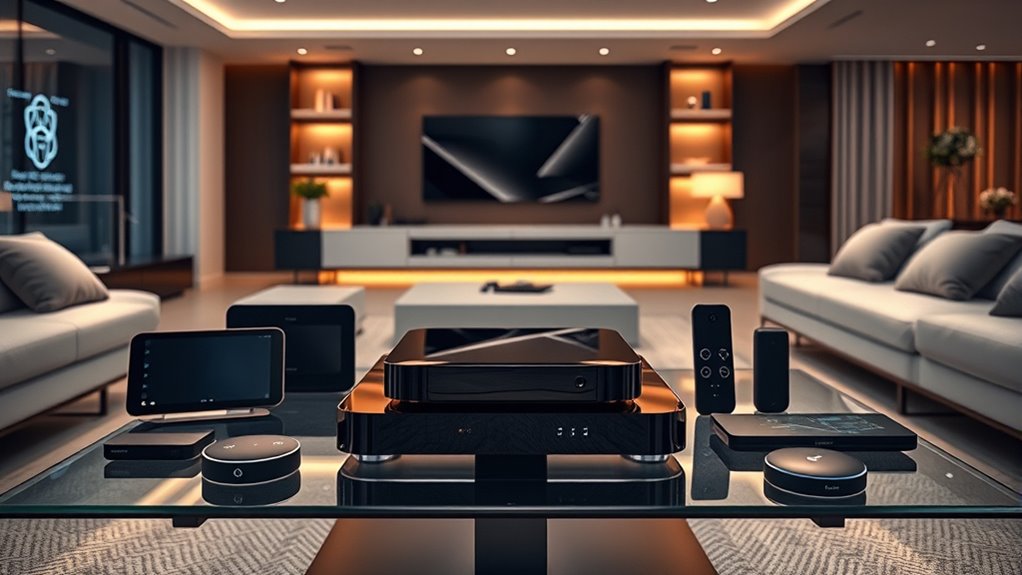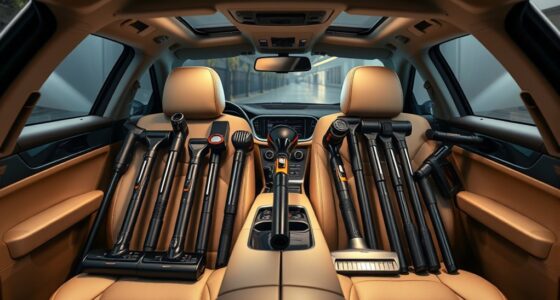If you’re looking to upgrade your smart home, I’ve found that the top premium hubs like Homey Pro, Hubitat Elevation, and SmartThings offer extensive device support, powerful automation features, and strong compatibility with major ecosystems like Alexa, Apple HomeKit, and Google Assistant. They support multiple protocols such as Zigbee, Z-Wave, and Matter, ensuring reliable connections and local processing for enhanced privacy. Keep exploring these options to find the perfect hub that elevates your smart home experience even further.
Key Takeaways
- The list features top-tier hubs supporting extensive device compatibility, including Zigbee, Z-Wave, Matter, and Wi-Fi protocols.
- These hubs offer robust local processing for enhanced privacy, security, and reliable operation during internet outages.
- They support complex automation, custom routines, multi-room setups, and seamless ecosystem integration with Alexa, Apple, Google, and more.
- Setup varies from plug-and-play to advanced configurations, with user-friendly apps and active communities for support.
- Devices provide versatile use cases such as energy monitoring, remote locking, security, and comprehensive smart home control.
Homey Pro Smart Home Hub for Automation
If you’re looking for a versatile and reliable smart home hub that supports a vast array of devices, the Homey Pro is an excellent choice. It connects with over 50,000 devices from more than 1,000 brands, including popular names like Sonos, Philips Hue, and Yale, plus voice assistants like Alexa, Siri, and Google Home. Its multi-protocol technology uses Wi-Fi, Zigbee, Z-Wave, Bluetooth, and more, all processed locally for faster, more secure automations. You can manage everything remotely via the app or web, creating custom flows for complex routines. Plus, its local processing guarantees your data stays private and routines run reliably, even without internet.
Best For: homeowners seeking a highly versatile, privacy-focused smart home hub that supports a wide range of devices and automation capabilities.
Pros:
- Supports over 50,000 devices from more than 1,000 brands, ensuring extensive compatibility.
- Local processing of automations enhances privacy, security, and reliability even without internet.
- Multi-protocol support (Wi-Fi, Zigbee, Z-Wave, Bluetooth, Matter, Thread) enables seamless integration of diverse devices.
Cons:
- May require a learning curve for creating complex automations and managing extensive device networks.
- The initial setup and configuration can be time-consuming for new users.
- Cost may be higher compared to simpler or single-protocol hubs.
Hubitat Elevation Home Automation Hub (Model C-8 Pro)
The Hubitat Elevation C-8 Pro stands out as an ideal choice for tech-savvy homeowners and automation enthusiasts who demand extensive device support and local control. Supporting over 1,000 devices from 100+ brands, it’s compatible with Alexa, Apple HomeKit, Google, Zigbee, Z-Wave, and Matter, ensuring broad ecosystem integration. Its local data processing boosts speed, privacy, and reliability, even during internet outages. The hub handles complex automations, custom dashboards, and security integrations effortlessly. With robust signal strength and a compact design, it’s perfect for larger homes. While setup can be challenging, the active community and all-encompassing resources make mastering this powerful hub rewarding.
Best For: tech-savvy homeowners and automation enthusiasts seeking extensive device support, local control, and customizable smart home automation.
Pros:
- Supports over 1,000 devices from more than 100 brands, ensuring broad compatibility
- Offers local data processing for faster, more reliable, and private automation control
- Flexible automation capabilities, including complex rules, dashboards, and security integrations
Cons:
- Setup and configuration can be complex and have a steep learning curve
- Managing remote access may require paid plans and additional setup steps
- The interface and device management settings are scattered, which may be challenging for new users
SmartThings Hub 3rd Generation (GP-U999SJVLGDA) Smart Home Hub
The SmartThings Hub 3rd Generation (GP-U999SJVLGDA) stands out as an excellent choice for homeowners seeking a versatile and easy-to-manage central control point for their smart devices. It supports Alexa, Google Home, Zigbee, Z-Wave, and cloud-to-cloud protocols, ensuring broad compatibility. With a single app, I can monitor and control all compatible devices, simplifying home management. Its automation features let me set routines, like turning on lights when I arrive or adjusting thermostats based on presence. This hub enhances convenience and security, seamlessly integrating my smart home ecosystem and offering reliable, centralized control.
Best For: homeowners seeking a versatile, easy-to-manage central hub for integrating and automating a wide range of smart home devices.
Pros:
- Supports multiple protocols including Zigbee, Z-Wave, Alexa, and Google Home for broad device compatibility
- Centralized control via a single smartphone app simplifies home management
- Enables automation of routines to enhance convenience and security
Cons:
- May require technical knowledge for advanced setup and troubleshooting
- Limited to compatible smart devices; not all products are supported
- Firmware updates or connectivity issues could temporarily disrupt smart home functions
Philips Hue Bridge Smart Lighting Hub
For anyone seeking a reliable and versatile smart lighting solution, the Philips Hue Bridge Smart Lighting Hub stands out as an essential centerpiece. It unlocks the full potential of your Hue system, supporting multi-room setups, automations, zones, and out-of-home control. With Zigbee technology, it provides a secure, stable connection that minimizes Wi-Fi strain and guarantees lights function reliably even when your Wi-Fi is down. The hub integrates seamlessly with voice assistants and Matter-compatible devices, making future-proofing effortless. Plus, it supports immersive entertainment by syncing lights with movies, music, and games, creating a dynamic, engaging smart home environment.
Best For: smart home enthusiasts seeking a reliable, comprehensive hub to control and automate multiple Hue lights and integrate with various voice assistants and Matter-compatible devices.
Pros:
- Supports multi-room setups, automations, zones, and out-of-home control for versatile lighting management
- Utilizes Zigbee technology for a secure, stable connection that reduces Wi-Fi strain and ensures reliable operation even during Wi-Fi outages
- Compatible with voice assistants and Matter devices, offering seamless smart home integration and future-proofing
Cons:
- Limited to supporting up to 50 lights and accessories, which may be insufficient for very large setups
- Requires a Hue Bridge for outdoor light control, adding extra hardware and setup complexity
- Does not include the Hue lights themselves, necessitating additional purchases for complete system deployment
If you’re seeking a smart button that offers seamless compatibility across major ecosystems, the arre Smart Button with Matter and Thread support stands out. It works effortlessly with Apple HomeKit and Samsung SmartThings, thanks to its Matter certification, ensuring reliable interoperability. Thread connectivity provides faster, low-latency communication, making control instant and responsive—though a Thread Border Route is required. The button supports Single, Double, and Long Press actions, allowing versatile control of your smart devices. Plus, it’s customizable with decorative stickers, including glow-in-the-dark options. Overall, this smart button simplifies managing your smart home while integrating smoothly across platforms.
Best For: smart home enthusiasts seeking a highly compatible, customizable button that integrates seamlessly across multiple ecosystems like Apple HomeKit and Samsung SmartThings.
Pros:
- Certified for Matter and Thread, ensuring reliable and broad interoperability
- Supports versatile actions: Single, Double, and Long Press for flexible control
- Includes decorative stickers, including glow-in-the-dark options, for personalization
Cons:
- Requires a Thread Border Route for Thread connectivity, which may involve additional setup
- Compatibility limited to ecosystems supporting Matter and Thread standards
- May need a hub or bridge for optimal integration within certain platforms
MOES ZigBee 3.0 Hub/Wired Gateway for Smart Homes
Designed for those seeking reliable ZigBee connectivity in their smart homes, the MOES ZigBee 3.0 Hub/Wired Gateway offers a compact, easy-to-install solution that seamlessly integrates multiple devices. Weighing just 5 ounces and measuring 4.02 x 3.9 x 1.93 inches, it covers over 200 meters and supports up to 20 devices. Powered via USB, it works with Tuya ZigBee products, Alexa, and Home Assistant. Customers appreciate its stable connection, straightforward setup, and broad compatibility. While it’s an affordable, reliable hub, some users note occasional connectivity glitches and brightness of activity LEDs. Overall, it’s a solid choice for expanding your smart home ecosystem effectively.
Best For: smart home enthusiasts seeking a reliable, easy-to-install ZigBee hub that supports multiple devices and integrates seamlessly with platforms like Alexa and Home Assistant.
Pros:
- Stable and reliable ZigBee connectivity over a coverage area of 200 meters
- Supports up to 20 devices, making it suitable for expanding smart home setups
- Easy to install with straightforward setup and broad platform compatibility
Cons:
- Bright activity LEDs with no option to disable them can be distracting
- Occasional connectivity issues with certain devices or brands
- Does not support Bluetooth devices and has limited compatibility with some smart locks and specific brands
Sengled Z02-hub Smart Home Hub (Pack of 1)
The Sengled Z02-hub Smart Home Hub stands out for its seamless Zigbee integration, making it an excellent choice for users who want to build a reliable, multi-device smart home ecosystem. It supports up to 64 Sengled devices, including lights and accessories, and works with Alexa, Google Assistant, and SmartThings. Setup is straightforward—just connect it to your router with the included Ethernet cable and follow the app instructions. While some users report range and pairing issues, overall, it offers convenient remote control, automation, and voice commands via the Sengled app. It’s a solid option for those seeking a centralized Zigbee hub with good compatibility.
Best For: users seeking a reliable Zigbee hub to integrate multiple smart devices, including lights and accessories, with voice assistant compatibility for a cohesive smart home setup.
Pros:
- Supports up to 64 Zigbee devices for comprehensive smart home control
- Compatible with Alexa, Google Assistant, and SmartThings for versatile voice control
- Easy to install with straightforward app setup and manual pairing options
Cons:
- Some users experience range and connectivity issues, especially over larger areas
- Pairing bulbs and devices can be challenging due to signal strength limitations
- Priced around $100, which may be considered expensive compared to Wi-Fi-only alternatives
Kasa Smart Plug HS103P4, Wi-Fi Outlet, 4-Pack
For homeowners seeking an affordable, reliable way to automate multiple devices, the Kasa Smart Plug HS103P4 4-pack offers an excellent solution. These Wi-Fi outlets support 15 Amp capacity, are UL certified for safety, and are compatible with Android 5.0+ and iOS 10.0+ devices. They work seamlessly with Alexa, Google Home, Echo, and IFTTT, allowing hands-free voice control. You can also control your devices remotely via the Kasa app and set schedules or timers for automation. Setup is straightforward—just connect to your 2.4GHz Wi-Fi and follow the app instructions. Trusted by over 5 million users, these smart plugs deliver convenience and reliability.
Best For: homeowners and renters seeking an affordable, reliable, and easy-to-use smart plug solution for automating and controlling multiple household devices.
Pros:
- Supports 15 Amp capacity and UL certification for safety and durability
- Compatible with popular voice assistants like Alexa, Google Home, and IFTTT for hands-free control
- Easy setup with no hub required—just connect to 2.4GHz Wi-Fi and follow app instructions
Cons:
- Limited to 2.4GHz Wi-Fi networks, not compatible with 5GHz
- Requires a smartphone with compatible OS (Android 5.0+ or iOS 10.0+) for setup and control
- Some users report occasional connectivity issues depending on Wi-Fi signal strength
Emporia Vue 3 Home Energy Monitor
If you’re serious about monitoring your home’s energy use and optimizing efficiency, the Emporia Vue 3 Home Energy Monitor stands out as a top choice. It provides real-time data on electricity consumption, supports solar and net metering, and works with various electrical systems. The device is UL and CE listed, ensuring safety and reliability, and includes sensors for critical loads like HVAC and water heaters. Installation is straightforward for qualified electricians, and the app offers detailed insights to help you identify high energy usage and reduce costs. With a 4.6-star rating, this monitor is proven to enhance energy management and savings.
Best For: homeowners and qualified electricians seeking comprehensive real-time energy monitoring, solar integration, and cost-saving insights to optimize home energy efficiency.
Pros:
- Supports a wide range of electrical systems, including single-phase, split-phase, and three-phase setups.
- Provides detailed circuit-level data to identify high energy consumption areas.
- Certified UL and CE listed, ensuring safety, reliability, and compliance with standards.
Cons:
- Installation requires electrical knowledge or a qualified electrician; not entirely DIY friendly.
- External antenna may be necessary for optimal signal in larger or complex panels.
- Some features, like additional sensors, are sold separately, potentially increasing overall cost.
SONOFF Zigbee 3.0 USB Dongle Plus Gateway
Looking for a reliable Zigbee USB adapter that seamlessly integrates with popular smart home platforms? The SONOFF Zigbee 3.0 USB Dongle Plus Gateway is exactly what you need. It’s pre-flashed with Z-Stack 3.x.0 firmware, uses the TI CC2652P chipset, and supports Home Assistant and IoBroker. With +20dBm output gain and an SMA interface for external antennas, it offers strong, flexible connectivity. Its aluminum housing minimizes interference, ensuring stable signals. Whether you’re expanding your Zigbee network or improving reliability, this dongle provides a straightforward, effective solution for robust smart home integration.
Best For: smart home enthusiasts seeking a reliable, easy-to-integrate Zigbee USB adapter compatible with popular platforms like Home Assistant and IoBroker.
Pros:
- Pre-flashed with Z-Stack 3.x.0 firmware for quick setup
- Supports external antennas with SMA interface for enhanced connectivity
- Aluminum housing reduces signal interference for stable operation
Cons:
- May require technical knowledge for installation and configuration
- Limited to Zigbee 3.0 protocol, not compatible with older Zigbee standards
- External antenna setup might be complex for beginner users
Lockin Wi-Fi Gateway and Electronic Lock Component for Smart Lock Control
The Lockin Wi-Fi Gateway and Electronic Lock Component stand out as an ideal choice for homeowners who want reliable remote control over their smart locks without the hassle of complicated setups. It’s compatible with popular devices like Q3/Q1 Smart Door Knob and L1 Smart Box, supporting seamless integration and flexible control options. Easy to install—just plug it in and connect via the app in under two minutes—its Wi-Fi connection guarantees secure, stable communication within 10 feet. Users can remotely manage access, monitor lock status, and view activity logs, all while enjoying voice control options with Amazon Alexa. Overall, it’s a straightforward, effective solution for smart lock management.
Best For: homeowners and property managers seeking reliable, easy-to-setup remote control and monitoring of multiple smart locks and lockboxes.
Pros:
- Simple plug-and-play installation within two minutes, no batteries required
- Supports remote access, activity monitoring, and integration with Amazon Alexa for voice control
- Compatible with popular smart lock devices like Q3/Q1 Smart Door Knob and L1 Smart Box
Cons:
- Not compatible with Lockin Veno series smart locks
- Some users report connectivity issues when using multiple units simultaneously
- Lacks a direct outlet plug, which could improve ease of placement and accessibility
Aqara Smart Lock U100 with Keyless Entry and HomeKit Compatibility
For homeowners seeking seamless integration with Apple’s ecosystem, the Aqara Smart Lock U100 stands out thanks to its HomeKit compatibility and support for Apple Home Key. You can open your door effortlessly with your iPhone or Apple Watch, even if the device’s battery is dead. It also works with Google Home, Alexa, and IFTTT via the Aqara Zigbee 3.0 hub, offering versatile automation options. The lock supports multiple access methods, including fingerprint, passwords, and mechanical keys, all secured with AES encryption. Its durable zinc alloy design, weatherproof rating, and emergency USB-C port make it both reliable and convenient for residential or commercial use.
Best For: homeowners and smart home enthusiasts seeking seamless Apple ecosystem integration, versatile access options, and durable, weatherproof security.
Pros:
- Fully supports Apple Home Key for contactless unlocking with iPhone and Apple Watch even when devices are out of power
- Multiple unlocking methods including fingerprint, remote passwords, mechanical key, and NFC cards (sold separately), with AES encryption for security
- Durable zinc alloy construction with IP65 weatherproof rating and emergency USB-C charging port for reliability in various environments
Cons:
- Requires a Zigbee 3.0 hub for remote password configuration and third-party integrations
- NFC cards are sold separately, adding to overall cost for full access options
- Battery life up to 8 months may require periodic replacement or backup power in high-use scenarios
SOLO Smart WiFi Door Window Sensor
If you want a reliable, no-hub-needed door and window sensor that offers real-time alerts, the SOLO Smart WiFi Door Window Sensor is a solid choice. It connects directly to your WiFi and sends instant notifications via the Smartlife app, compatible with Alexa and Google Home. Suitable for various entry points like doors, windows, safes, and pet doors, it helps keep your home secure. The sensor features durable materials, a 300-foot range, and simple wall mounting with included tape. While some users report adhesive issues, it provides essential security alerts and supports event history and battery monitoring, making it a practical addition to your smart home setup.
Best For: homeowners seeking a reliable, easy-to-install WiFi door/window sensor with real-time alerts and smart home compatibility without the need for a hub.
Pros:
- No hub required, easy WiFi setup directly via the Smartlife app
- Compatible with Alexa and Google Home for voice control
- Supports app control, event history, and battery monitoring for comprehensive security
Cons:
- Reports of adhesive tape issues leading to sensor detachment and malfunction
- Inconsistent performance reported by some users, especially with Alexa integration
- Batteries are not included, requiring an additional purchase
Kasa Smart Switch 2-Gang HS200-2 Wi-Fi Light Switch
Designed for homeowners seeking a sleek, reliable way to control multiple lights simultaneously, the Kasa Smart Switch 2-Gang HS200-2 stands out with its dual switch setup and intuitive app integration. It allows me to manage two separate circuits easily, thanks to its elegant flush design and interchangeable terminals. Compatible with Alexa, Google Assistant, and SmartThings, I can control my lights via voice or app without a hub. Installation is straightforward with clear instructions, provided I have a neutral wire. The switch offers scheduling, timers, and grouping features, making my lighting smarter, more customizable, and seamlessly integrated into my home automation system.
Best For: homeowners seeking a sleek, reliable, and customizable way to control multiple lights simultaneously without the need for a hub.
Pros:
- Easy installation with clear, guided instructions and a modern flush design
- Compatible with popular voice assistants like Alexa, Google Assistant, and SmartThings for hands-free control
- Supports scheduling, timers, and grouping for enhanced automation and convenience
Cons:
- Requires a neutral wire and may not fit in all electrical boxes, especially in regions with smaller or deeper boxes
- Not compatible with 3-way switch configurations, limiting certain wiring setups
- Potential software bugs on Android devices during setup may require troubleshooting
Smart Switch Button Pusher with Bluetooth and App Control
The Smart Switch Button Pusher with Bluetooth and App Control stands out as an ideal choice for those seeking a simple, wire-free solution to automate various devices. It requires no wiring and connects easily via Bluetooth, allowing remote control through the Tuya app, Alexa, or Google Home. I appreciate its versatility—it’s great for controlling computers, TVs, garage doors, and more. The device is built from durable, polished plastic, ensuring reliable performance. Setup is straightforward with the included toolkit, making it accessible even for beginners. Overall, it’s a practical, high-quality addition to any smart home, enhancing convenience and automation effortlessly.
Best For: those seeking a simple, wireless solution to automate and remotely control various household and electronic devices without complex wiring.
Pros:
- Easy to install with included toolkit, suitable for beginners
- Compatible with popular smart home platforms like Tuya, Alexa, and Google Home
- Durable construction from polished plastic ensures reliable, long-lasting performance
Cons:
- Limited to Bluetooth connectivity, which may affect range compared to Wi-Fi devices
- May require a smartphone app for operation, potentially complicating use for non-tech-savvy users
- Compatibility depends on the specific switch types and devices, possibly limiting certain applications
Factors to Consider When Choosing Premium Home Automation Hubs

When choosing a premium home automation hub, I consider factors like protocol compatibility, local control options, and how easily it integrates with my existing ecosystem. I also look for automation flexibility, strong privacy and security measures, and whether it offers straightforward setup. These points help guarantee I pick a hub that’s reliable, secure, and fits my smart home needs.
Protocol Compatibility Range
Choosing a premium home automation hub with broad protocol compatibility is essential for creating a flexible, future-proof smart home. A wide protocol range allows the hub to communicate with devices using Zigbee, Z-Wave, Wi-Fi, Bluetooth, Thread, and Matter, expanding your options. It also impacts coverage, especially in larger or multi-floor homes, as the effective range depends on signal strength and obstacles. Supporting multiple protocols simultaneously means you can integrate devices from different ecosystems without needing multiple hubs. Additionally, protocol interoperability—especially with emerging standards like Matter—ensures your devices work seamlessly together and remain compatible as technology evolves. Keep in mind, physical obstructions, interference, and antenna design can affect signal strength and reliability, so choosing a hub with robust protocol support is key.
Local Control Capabilities
A home automation hub that offers strong local control capabilities keeps your smart devices running smoothly even if your internet goes down. This guarantees your automation routines, security systems, and critical functions remain operational without relying on cloud services. Devices with robust local processing respond faster to triggers, reducing latency and improving your overall user experience. Plus, managing your devices locally enhances security and privacy, as less data is sent externally. Local control also allows for real-time monitoring and quicker troubleshooting, minimizing downtime and dependency on third-party servers. When choosing a premium hub, prioritize those with solid local control features to guarantee reliability, security, and seamless performance—even during internet outages. It’s a crucial factor for a truly dependable smart home.
Ecosystem Integration Ease
Seamless ecosystem integration is essential for a premium home automation hub, as it determines how easily your devices work together across different platforms and protocols. A good hub supports multiple ecosystems like Apple HomeKit, Google Home, Alexa, and protocols such as Zigbee or Z-Wave, ensuring broad compatibility. Support for standards like Matter simplifies device pairing and boosts interoperability across brands. An intuitive setup process with straightforward device pairing, minimal configuration, and clear instructions reduces barriers to integration. Compatibility with industry-standard protocols like Thread and community-developed apps further expands your ecosystem options and future device compatibility. Ultimately, a centralized control interface—accessible through a single app—allows effortless management across ecosystems, making your smart home more cohesive and user-friendly.
Automation Flexibility Features
To get the most out of a home automation hub, you need one that offers robust automation flexibility. I look for hubs supporting multiple protocols like Zigbee, Z-Wave, Wi-Fi, Bluetooth, and Matter, which allows me to connect a wide range of devices seamlessly. The ability to craft complex automations with multi-step processes, conditional logic, triggers, and timers makes my routines highly personalized and dynamic. I also value support for custom scripting and third-party app integrations, which extend automation possibilities beyond basic features. User-friendly tools like visual flow builders or rule editors help me design intricate scenarios without hassle. Finally, compatibility with voice assistants and remote apps guarantees I can trigger or modify automations effortlessly from anywhere, giving me complete control over my smart home.
Privacy and Security Standards
Ensuring your home automation hub prioritizes privacy and security is essential, especially as devices become more integrated into daily life. I look for hubs that process all automation data locally, reducing dependence on cloud services and minimizing potential breaches. Support for encrypted communication protocols like Zigbee, Z-Wave, or Thread is critical to protect device data during transmission. I also verify that the system has strong user access controls and authentication methods to prevent unauthorized access. Regular security updates and patches are crucial to stay ahead of emerging vulnerabilities and maintain data integrity. Additionally, I check if the hub complies with industry standards and certifications, such as UL or GDPR, to ensure it meets strict privacy and security regulations. These features give me confidence that my smart home remains secure and private.
Device Compatibility Scope
Choosing a premium home automation hub requires careful attention to its device compatibility scope, as this determines how well your smart home will function and expand over time. I look for hubs that support multiple communication protocols like Zigbee, Z-Wave, Wi-Fi, Bluetooth, and Matter, guaranteeing broad device compatibility. Compatibility with popular ecosystems such as Apple HomeKit, Google Home, and Amazon Alexa is also essential for seamless integration. A versatile hub should support a wide range of device types—from lighting and locks to sensors, thermostats, and security cameras—so I can customize my setup. Firmware and app support for both official and community-developed integrations expand device options further. Future-proofing with support for emerging standards like Thread and Matter ensures my system remains compatible long-term.
User Interface Simplicity
A home automation hub with a simple user interface makes managing your smart devices much easier. It reduces the learning curve, so you can set up and control your devices without frustration. Clear navigation menus and intuitive controls help you quickly find and customize automation routines, saving time and effort. Visual automation builders, like drag-and-drop flows, make complex scenarios easier to create and understand. Consistent design language and minimal clutter improve usability, especially for those new to home automation or less tech-savvy. Additionally, a responsive interface that works seamlessly across mobile and web platforms ensures you can monitor and control your smart home from any device, anytime. Prioritizing user interface simplicity guarantees a smoother, more enjoyable smart home experience.
Frequently Asked Questions
How Do Premium Hubs Ensure Compatibility With Various Smart Home Devices?
Premium hubs guarantee compatibility by supporting multiple protocols like Zigbee, Z-Wave, and Wi-Fi, which cover most smart devices. I find that they’re designed to automatically recognize and integrate new devices, making setup seamless. They often come with extensive compatibility lists and regular updates, so I know my system stays current. This versatility lets me connect various brands and devices without worrying about compatibility issues, creating a truly cohesive smart home.
What Security Features Are Integrated Into High-End Home Automation Hubs?
Think of high-end home automation hubs as digital bodyguards. They come with robust security features like end-to-end encryption, multi-factor authentication, and regular firmware updates that keep your smart home safe from intruders. Many also include intrusion detection and secure remote access, so you can control your devices confidently. These features act as an unbreakable shield, ensuring your connected home remains private and protected at all times.
Can Premium Hubs Support Future Technology Updates and Standards?
Yes, premium hubs are designed to support future technology updates and standards. I’ve found that they often feature firmware upgrade options, backward compatibility, and open integrations, making it easier to add new devices or adapt to evolving protocols. This guarantees my smart home stays current, secure, and functional for years to come, giving me peace of mind and a more seamless experience as technology advances.
How Do Premium Hubs Handle Network Congestion and Device Interference?
Steering the subtle dance of network congestion, premium hubs often employ advanced algorithms to prioritize traffic and minimize interference. They intelligently allocate bandwidth, smoothly managing multiple devices without missing a beat. With built-in spectrum analysis, they can identify and adapt to sources of disruption, ensuring your smart home runs seamlessly. This sophisticated approach transforms potential chaos into a harmonious experience, giving you confidence in your connected environment.
What Is the Typical Lifespan and Warranty Coverage for Premium Smart Home Hubs?
Premium smart home hubs typically last between five to ten years, depending on usage and technological advancements. I’ve found most come with a warranty of one to three years, covering hardware defects and technical support. Regular firmware updates help prolong their lifespan and improve functionality. I recommend checking each product’s specific warranty details, as coverage varies by manufacturer, to guarantee your investment stays protected over time.
Conclusion
So there you have it—my top picks for premium home automation hubs. Whether you’re into sleek design, robust features, or just want to pretend you’re living in the future, there’s a hub for everyone. Just remember, with great smart power comes great responsibility… and maybe a few accidental door *unlatchs* at 2 a.m. But hey, at least you’ll be living your best sci-fi life. Happy automating!





![SmartThings Hub 3rd Generation [GP-U999SJVLGDA] Smart Home Automation Hub Home](https://m.media-amazon.com/images/I/21hChu0ounL._SL500_.jpg)



















